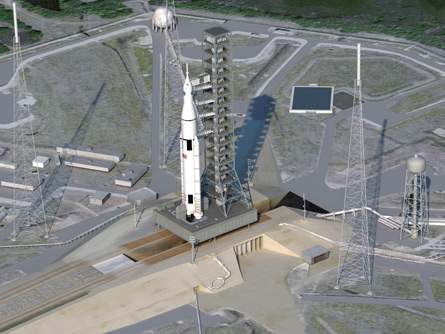As NASA plots the future of the Space Launch System (SLS) programme and fends off accusations that it is starving the funding of the commercial crew development (CCDev) programme, the administration is keen to point out that it is concentrating on limiting both development and, most importantly, the future operating costs of the SLS.
NASA's Dr. Michael Watson, Discipline Lead Engineer of SLS operations noted at the American Institute of Aeronautics and Astronautics (AIAA) SpaceOps conference held in Stockholm, Sweden, that the SLS development team have got wise to the fact that their current and future political masters are most interested in "costs now rather than costs past" and are concentrating on developing a heavy lift launch vehicle whose costs to operate will be lower than past heavy lift launch vehicles.
It is not only operational costs that are making NASA engineers concentrate. NASA admits that flat spending levels on the SLS launch vehicle development have given the design team limitations, but that they were making the best of it.
NASA is now becoming adept at using what they have rather than building all new infrastructure and hardware. Apart from using past rocket engines and tank systems from the Space Shuttle, Hector Delgado, Chief Engineer of Design and Developments at the Kennedy Space Centre described how the main structure of the launch tower came from the now cancelled Project Constellation Ares launcher programme, while the pad's water suppression tanks are from the Shuttle programme. The flame trenches originated from the Saturn V Apollo era.
|
|---|
NASA Saturn IB on its "milk stool" reconfigurable pad |
Delgado notes that one idea for reducing operational costs would be to increase the utilisation of the SLS launch pad by making it reconfigurable for different versions of SLS and even other launch vehicles (the SLS is projected to fly at most three times a year) even if SLS operations have priority. This reconfiguration would include having propellant umbilical arms mounted on rails which would be moveable up and down the launch tower which would allow rockets of different heights to be serviced. "Having moveable umbilicals on the tower is the key" said Delgado has he noted that Atlas and Delta IV launch vehicles might also be able use the facilities.
Delgado noted that this would not be NASA's first experience of using the same pad for different launch vehicles. For the Apollo and Skylab low Earth orbit (LEO) flights, the Saturn IB launch vehicle (the smaller sibling to the Saturn V) was launched raised platform dubbed the "milk stool" to allow it to reach its crew entry bridge and umbilical services.
While NASA's engineering team, in conjunction with its contractors, are designing to the legally required brief, would these restrictions and limitations affect future development of the SLS? Fitting the tall rocket through the undersized door of the Vehicle Assembly Building is one obvious limitation on the SLS but there are others. In its largest configuration with two Block 2 boosters (using either advanced solids or liquid fuel boosters) SLS is currently projected to have a LEO payload in the 130-160 tonne region. NASA executives admit that this could be stretched to 200 tonnes in a four booster configuration but that this could be expensive, and in any case is not imminently required.
 |
|---|
NASA The pad for SLS will have to cope with different versions of the launch vehicle |
Jerry Cook, Associate Programme Manager for SLS noted, "we could go to four boosters at a later stage but for the time being this is restricted by pad infrastructure." This was confirmed by Delgado, who admitted that while the mobile launch pad was being modified with a rectagular slot to accept the main core and boosters of SLS, it would be difficult to get first stage refueling lines in and keep the structure stable if the exhaust "hole" configuration in the mobile pad was changed to a four booster one. Delgado warned that with only 15m (50ft) of clearance, a safe launch of a vehicle using four boosters would be hard to achieve. Delgado also reminded that the umbilical arms have to be got out of the way as fast as possible, especially if inextinguisable/unthrottleable solid rocket boosters are used. "Once those are fired there is no stopping them," he said.
Source: Flight International























